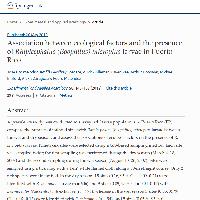Resumen
-
A prevalence study was conducted to survey tick larvae populations in Puerto Rico (PR), compare the number of infested sites with Rhipicephalus (Boophilus) microplus larvae between the wet and dry season, and assess the associations of ecologic factors on the presence of R. microplus larvae. Ninety-six sites were selected using a GIS-based sampling method. Each site was sampled twice; the first sampling was performed during the dry season (March 4–18, 2007) and the second sampling during the wet season (August 13–26, 2007). Sites were sampled using a tick drag with a 1-m2 white flannel cloth along a 50-m straight course. Only 2 tick species were identified. In the dry season, 15 sites (0.16, 95 % CI = 0.09–0.24) were identified with R. microplus larvae (n = 606) and 9 sites (0.09, 95 % CI = 0.04–0.17) with Dermacentor (Anocentor) nitens larvae (n = 779), whereas in the wet season 5 sites (0.05, 95 % CI = 0.02–0.12) were identified with R. microplus (n = 94), and 5 sites (0.05 %, 95 % CI = 0.02-0.12) with D. nitens (n = 275). Difference in the number of infested sites with R. microplus was significant (P = 0.031) between the 2 seasons. Factors associated with the presence of R. microplus larvae in PR were wind speed of >4.0 km/h (OR = 0.07, 95 % CI = 0.01–0.63), more than 25 % bushes and shrubs on the site (OR = 11, 95 % CI = 1.6–71), and presence of cattle on the site (OR = 26, 95 % CI = 3.4–188).
